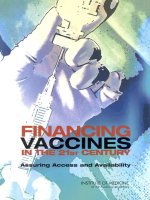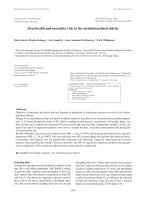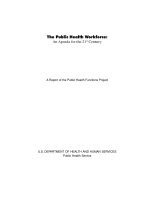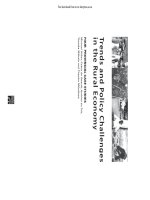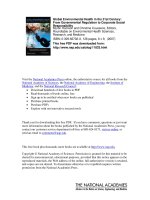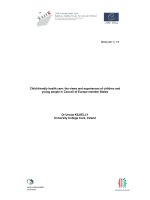Sex, health and young people in the 21St century pot
Bạn đang xem bản rút gọn của tài liệu. Xem và tải ngay bản đầy đủ của tài liệu tại đây (2.77 MB, 44 trang )
SEX, HEALTH AND YOUNG PEOPLE
IN THE 21
ST
CENTURY
WHO WE ARE
The International Planned Parenthood
Federation (IPPF) is a global service
provider and a leading advocate of sexual
and reproductive health and rights for
all. We are a worldwide movement of
national organizations working with and for
communities and individuals.
IPPF works towards a world where women, men and young
people everywhere have control over their own bodies, and
therefore their destinies. A world where they are free to choose
parenthood or not; free to decide how many children they will
have and when; free to pursue healthy sexual lives without fear
of unwanted pregnancies and sexually transmitted infections,
including HIV. A world where gender or sexuality are no longer
a source of inequality or stigma. We will not retreat from doing
everything we can to safeguard these important choices and
rights for current and future generations.
Acknowledgements
IPPF would like to thank all who helped create Stand and Deliver: Sex, health
and young people in the 21st century. Our sincere thanks goes to the Ministry of
Foreign Affairs of the Netherlands, to YouAct (the European Youth Network on
Sexual and Reproductive Rights), to the Youth Coalition for Sexual and Reproductive
Rights and to the World YWCA for their contributions and for reviewing drafts
of the publication. Thank you to Dennis Ferhatovic, Sadaf Nasim and Milinda
Rajapaksha, IPPF youth volunteers; to IPPF Regional Offices; and to the Central
Office Resource Mobilization Team for their assistance and support. The Advocacy
and Communications team at Central Office wrote and produced Stand and Deliver,
with important contributions from the Youth and HIV teams. This publication was
made possible through the generous support of the SALIN+ Fund, an initiative of
the Netherlands. Thank you all.
Foreword: Andrea Núñez Argote, youth volunteer, YWCA 4
Foreword: Bert Koenders, Minister for Development Cooperation
of the Kingdom of the Netherlands 5
Foreword: Dr Gill Greer, Director-General of IPPF 6
INTRODUCTION 8
Young/vulnerable 10
Why now? 13
YOUNG PEOPLE’S SEXUAL AND REPRODUCTIVE HEALTH 16
Case study: Mauritania – An inconvenient marriage 19
Case study: Bolivia – Supporting young people to bring home the bread 20
CULTIVATING MINDS AND BODIES: THE BUILDING OF A CITIZEN 22
Creating youth-friendly services 24
Case study: Tanzania – Abortion, the choice that never was 27
Faith, religion and sexuality 28
YOUNG PEOPLE’S HUMAN RIGHTS 30
Love, life and HIV: Young people living with HIV 31
Case study: Uganda – Promoting empowerment, respect and civil responsibility 32
Case study: Europe – Youth Advocates in Action 33
Case study: Southeast Asia – Building a youth advocacy movement 34
RECOMMENDATIONS 36
CONCLUSION 38
References 40
CONTENTS
Foreword
ANDREA NÚÑEZ ARGOTE
YOUTH VOLUNTEER, YWCA
Young people are not only the future generation, we are the present. In
my own experience, young people are not fully aware of their sexual and
reproductive health and rights (SRHR).
Today, most young people still do not have access to information, proper guidance
and supportive services, neither from the health sector nor our teacher and parents,
who are often uncomfortable talking to us about sex and sexuality.
In my own country, México, the Ministry of Health provides general information
in the school curricula for students to understand their sexuality and reproductive
health. General information is not enough – we need comprehensive information
with ample time to discuss difficult issues in an open manner. When teachers skip
these topics, we don’t get the information we need. Instead we are left to talk
about these issues with our friends, who know the same or less than us, and all too
often we are ashamed to ask for the information in fear of being criticized.
In many cases, young women and girls are not treated equally to young men
and boys. We know that family values and gender roles are inherited from our
forefathers and foremothers and that cultural environments also influence gender
dynamics. I understand that I have the ability and that I am empowered enough to
break this cycle. It is my responsibility to remember this when I become a mother.
Everything depends on the will of communities to accept this kind of change and
most of the time young people are more open to change.
This publication makes reference to non-governmental organizations (NGOs) such as
Asonat, where young people can access SRHR information and services. We need
more organizations like Asonat, which understand the social determinants of young
people’s lives. Asonat reminded me of my association back home – the YWCA of
Naucalpan – where I work as a volunteer. We have a programme on HIV and AIDS
prevention, and we also address SRHR. We provide safe places for young people
to access the information they need through activities such as dance classes, karate
and drawing.
I believe that this publication provides a rich source of information on SRHR for
young people. We need to know what our rights are, we need to understand our
own background, we need to learn from all this to create a better future for all, and
we need to do this today.
Stand and Deliver: Sex, health and young people in the 21st century
4
Over half of the world’s population is under 25 years old. Investing in
and involving these young people and engaging them as partners in
development – all this is crucial for building a more just world. I am pleased
that this report addresses a number of the critical issues facing young
people today, particularly their unmet needs for comprehensive sexuality
education and sexual and reproductive health services.
Young people have the right to be fully informed about sexuality and to have
access to contraceptives and other services. These rights are enshrined in various
internationally agreed human rights conventions and treaties, but – unfortunately
– they are still not universally respected. This explains why the Netherlands’ policies
on foreign affairs and development are centred on human rights. And why
the Dutch government remains committed to the Programme of Action of the
International Conference on Population and Development. Our support to IPPF and
other organizations which implement this important agenda is testimony to this
commitment.
Young people deserve special attention in development settings, where they
often lack access to services that adults in many countries take for granted. This
makes young people vulnerable. Millions do not know how to protect themselves
against unwanted pregnancy or sexually transmitted infections such as HIV, or are
ill equipped to do so. Young women and girls lack decision-making power and
many are subjected to gender-based violence every day. In many places, lesbian,
gay, bisexual and transgender young people live in fear of discrimination and
stigmatization. Numerous countries do not regard sexual health or rights as a
legitimate part of the public duty of care or acknowledge that young people are
sexual beings. The taboo on youth sexuality is one of the key forces driving the AIDS
epidemic and high rates of teenage pregnancy and maternal mortality.
I believe that as a matter of urgency, we must make progress on achieving the
Millennium Development Goals – notably MDG 3 (promoting gender equality and
empowering women) MDG 5 (improving maternal health) and MDG 6 (combating
HIV/AIDS, malaria and other diseases). The whole world needs to accept that many
young people, married and unmarried, are sexually active. Governments, donors,
communities, leaders and individuals, all have a role to play in creating a safe and
enabling environment where young people get the support and care they need for
good sexual and reproductive health and rights, and where they have a real say in
matters concerning their bodies and their health.
Together, let us finally recognize young people as catalysts for change. Let us enable
them to develop their full potential – for their own sake and for the sake of their
future.
Foreword
BERT KOENDERS, MINISTER FOR
DEVELOPMENT COOPERATION OF THE
KINGDOM OF THE NETHERLANDS
Stand and Deliver: Sex, health and young people in the 21st century
5
Foreword
DR GILL GREER
DIRECTOR-GENERAL OF IPPF
While all young people have important contributions to make, our ability
to reach girls and young women – to provide them with support and care
at critical times and to give them opportunities to participate – will have
a profound impact on their families, communities and countries. In many
ways women are the drivers of development.
As Stand and Deliver demonstrates, however, poverty and inequity make girls and
young women vulnerable, threatening not only their individual well-being and
human rights, but the realization of development goals.
Stand and Deliver highlights facts we have known for decades, but have been
neglected until now: girls and young women bear a disproportionate burden of
sexual and reproductive ill health and mortality, including maternal mortality, unsafe
abortion and HIV. Why do they suffer needlessly? The answer is simple: they have
little power over their own lives. While realizing the solutions are not easy, we
know what needs to be done. We must focus special attention on the needs of
girls and young women. Greater investment in primary and secondary education
for girls, comprehensive sexuality education for boys and girls, both in and out of
school, which can break down gender stereotypes, and provision of youth-friendly
services that ignore taboos and stigma around intimacy and sex will empower girls
and young women. Young women, like young men, must be given the freedom to
assume leadership and responsibility for building a better world.
Stand and Deliver: Sex, health and young people in the 21st century presents us
with some choices and recommendations that can transform today as well as
tomorrow. I trust and hope, with young women and young men as our partners,
that we will make choices that contribute to gender equality, social justice and a
truly better world for all.
Stand and Deliver: Sex, health and young people in the 21st century
6
Every week there is a new virus, or a financial collapse, a
catastrophic hurricane or a drastic increase in food shortages,
and the ramifications that follow rumble on through days
and months, sometimes years, brushing by some people and
hitting others square on. Climate change and rapid population
growth – a potent, foreboding pair – are already delivering
blows that are sudden and staggering; they are also causing
cumulative, damaging environmental change that makes
people’s everyday lives increasingly difficult. Rich and poor,
young and old feel the impact of global crises, in developed
and developing countries. The difference lies in the resources
that are available to adapt and rebuild, and, most especially,
of the capacity of individuals to confront change. Where
people are empowered to take the reins and make decisions
to ensure their own security and well-being, as well as that of
their families, communities are resilient and peace is secure.
As globalization accelerates the speed at which risks to
health and home spread around the globe, building a world
of empowered global citizens is an urgent and revolutionary
challenge. It is one we cannot afford to delay.
The world is home to the largest generation of young
people in history – more than 1.75 billion people between
10 and 24 years of age.
1
They are a vastly diverse group of
individuals whose life circumstances, including opportunities
and obstacles to improve their lives, vary significantly from
one country to the next, and even from one area to another
within a single country. The majority of young people live
in developing countries
2
and 42 per cent live in poverty.
3
Capabilities among them range widely: some young people
are income-poor and thus face barriers in many areas of their
daily lives; others are poor in health, particularly sexual and
reproductive health; and some are excluded from political,
social and labour market participation. Young people in the
poorest areas often lack access to essential resources such
as clean water, good sanitation and food, a situation that
is perpetuated by illiteracy and limited access to education.
Many young people have yet to exercise their basic right to
choose a life that they value.
Despite all of this, young people everywhere are an
inexhaustible source of ideas, energy and optimism. All
through history, young people have broken away from
negative behavioural patterns and changed intergenerational
cycles of discrimination and poverty. They have the potential
to build a world that is inclusive and compassionate, for
people and for the planet, and the good news is they want to
be involved!
In this report we take a good look at the lives of young
people, their needs for comprehensive sexual and
reproductive health services, their unmet needs and their
desires, in a global context that is presenting us with daunting
challenges that will shape the future. Supported by evidence
at the country level, we argue that the only way to build
a more just world is to invest in and involve young people,
to support them to be decisive, adaptable, informed and
assertive citizens, and to engage with them as partners in
development. This generation of young people is a gift and an
opportunity that will not come around a second time.
Now, more than ever, problems emerging
in other parts of the world directly affect
our societies, our economies and our lives.
Stand and Deliver: Sex, health and young people in the 21st century
8
A whirlwind on the social scene, Milinda, 24, first
joined the Family Planning Association of Sri
Lanka as a peer educator in 2004. He received
training, and then went out to meet young
people in 16 districts to reveal all about sexual
and reproductive health and rights. Milinda was
hooked: he saw the need for information and
services and made it a personal mission to raise
awareness of young people’s issues. Since then,
Milinda spearheaded the development of the
national youth policy, he has become the convenor
of a national civil society forum, and he founded
REACH, Sri Lanka’s first youth conference on HIV
and AIDS, and the National Youth Coalition on
Sexual and Reproductive Rights.
“I always ask young people to believe in
their rights because health is not a benefit,
but a fundamental right. I work to develop
the capacity of young people like me to do
effective advocacy, to work with media and
ensure a rights-based approach.”
YOUNG/VULNERABLE
Young people represent a significant proportion of the overall
population in low income countries, and they also represent
a disproportionate burden of global poverty. The Chronic
Poverty Research Centre has identified three critical societal
features that keep poor people poor: limited citizenship, social
discrimination and poor work opportunities.
4
Most young
people in developing countries struggle with one, two or all
three of these barriers, which also contribute to the relentless
cycle of intergenerational poverty, to instability at the
household level and state fragility.
¼
Nearly 93 million young people are unemployed
5
¼
Young people (between 10 and 24 years) account
for two-thirds of premature deaths
6
¼
One-third of the total disease burden in adults
can be attributed to behaviours or events from
adolescence, including smoking, exposure to
violence, mental illness and unsafe sex
7
DEFINING ADOLESCENCE
As most societies define adolescence and youth in terms
of both age and life circumstances, there is no universal
agreement on what is a ‘young person’. The national
legal age for political participation and the availability of
data on different age groups can also determine how
societies define youth. The World Health Organization
defines young people as those from 10 to 24 years of
age, including adolescents (10–19 years) and youth (15–24
years). IPPF uses the terms young people, youth and
adolescents interchangeably to refer to people who are
between 10 and 24 years. Defining all people under 18
years of age as a child is often not useful because it ignores
the circumstances of youth who are faced with pressures
and responsibilities that are usually reserved for adults.
Policies and programmes for young people should focus
not so much on age, but on the specific developmental
needs and rights of individuals as they transition from
childhood to adulthood.
While the current generation of young
people are an opportunity, at present they
face incredible barriers to improving their
lives and contributing to society.
Stand and Deliver: Sex, health and young people in the 21st century
10
“Tackle the inequitable distribution of power, money, and
resources – the structural drivers of the conditions of daily
life – globally, nationally and locally.”
One of three key recommendations made by the World Health Organization
Commission on the Social Determinants of Health
8
FIGURE 1: INTERNET USE BY YOUNG PEOPLE, AGED 15–24
Source: International Telecommunication Union (2008) Use of information and communication technology by the world’s children and youth Geneva: ITU
Disparities in access to essential basic services, such as
sanitation, clean water, health, education and access to the
judiciary system, are fundamental inequities that can produce
lifelong inequalities and deep-seated feelings of injustice.
These inequities extend to things like access to information:
while access to communication technologies, including the
internet, may seem like a luxury, in reality it means that while
most young people in developed countries, and the wealthier
young people in poor countries, can obtain the information
they seek, others cannot (see Figure 1). The violation of
young people’s rights to information, to health care services,
to contraception and counselling, to education, to political
and social participation, and to health is a denial of their
personhood and of their citizenship.
Young people suffer social discrimination on multiple accounts,
first because they are poor and again because they are
young. Marginalized young people, including men who have
sex with men, sex workers, transgendered people, young
people in rural areas or in urban slums, and others are further
stigmatized. Girls’ and young womens’ choices are especially
limited.
In some countries, persistent inequity has resulted in socially
and politically volatile populations; frustrated youth are
vulnerable to the appeals of fundamentalist, religious or
political groups.
9
The lack of opportunities to improve their
lives leaves young people with nowhere to go and no one to
turn to: they become caught in the poverty trap, and escape,
for many, can seem like an impossible dream. If we are going
to give these young people any chance at all to create a life of
their choosing, we must invest in social programmes to reach
out to marginalized youth, including through civil society
organizations, to help build their self-esteem and give them
opportunities for education and training.
Australia
Bermuda
EU27
Iceland
Japan
New Zealand
Norway
United States
DEVELOPED
COUNTRIES
DEVELOPING
COUNTRIES
Azerbaijan
Brazil
China
Costa Rica
Malaysia
Mauritius
Mexico
Morocco
Paraguay
Thailand
0%
10%
60%
50%30% 80%20% 70%
40%
90% 100%
Stand and Deliver: Sex, health and young people in the 21st century
11
Countries should aim to meet the needs and aspirations of
youth thereby ensuring their integration and participation
in all spheres of society, including participation in the
political process and preparation for leadership roles.
ICPD Programme of Action, paragraph 6.13
When both young women and young men are fully informed
and engaged, with the freedom to pursue higher levels
of education and access to youth-friendly health services,
they become concerned and contributing citizens in the
community. As such, they are often able to escape poverty
and help others to do the same.
A youth health research organization based at Melbourne
University reports that young people’s experience of
“engagement, belonging and connectedness are protective
factors in the prevention of long-term mental and physical
health and social problems.”
10
Protective factors and processes
may be located within the young person (e.g. learned
attitudes or beliefs), in the family (e.g. caring adults) or in
schools and the community. As the number of protective
factors and processes surrounding a young person increases,
the more resilient he or she becomes. While these findings are
based on evidence in developed countries, the same is true in
the developing world.
Investing in sexuality education, social programmes for youth,
youth-friendly sexual and reproductive health services, and
promoting gender equality are vital to help young people
develop the ability to cope with and respond to an ever-
changing world. Governments should also seek to provide
social protection to help young people avoid falling into
poverty, or to help them escape it, and to help them plan
and lead a productive, healthy life. In the long-term, resilient
citizens translate into resilient communities and resilient states.
Social protection means protecting the vulnerable
against risks that threaten their livelihood or income, and
enhancing the social status of marginalized groups.
11
Social protection may include transfers of money or goods,
welfare services and social policies.
Government is unable or unwilling
to meet population’s needs
Efficient delivery of
essential public services
Lack of employment opportunities Citizens can act to improve
their lives
Repressed political competition Robust political processes and
civil participation
Inability to deal with
disasters and shocks
The ability of individuals to cope
with change and plan for crises
Vulnerability to violent
internal conflict
Capacity to manage and resolve
conflict without violence
Source: OECD (2008) Concepts and dilemmas of state building in fragile situations. Paris: OECD.
FIGURE 2: THE FRAGILITY – RESILIENCE CONTINUUM
Stand and Deliver: Sex, health and young people in the 21st century
12
WHY NOW?
Countries that have a large proportion of young people
– that is, those with a ‘youth bulge’, primarily low
income countries – have some characteristics that can
make young people vulnerable. However, the structure
of these populations is also a unique, time-bound
opportunity for future growth and development.
Many developing countries have experienced demographic
transition in the past several decades. That is, “as death rates
decline, followed later by a decline in birth rates, populations
grow rapidly [and then] eventually plateau at a relatively
stable level.”
12
(see Figure 3: The demographic transition) This
is already occurring in countries like Bangladesh, Egypt and
Peru. In these countries the risk of civil conflict is declining and
there is tremendous opportunity to stimulate future economic
growth by supporting an upcoming workforce.
13
In these contexts, young people have the potential to develop
into a large, productive workforce, an informed and capable
citizenry who will transform their countries into secure,
healthy and peaceful nations.
14
This ‘demographic bonus’ is a
one-time opportunity, it is a “period of as many as 50 years
during which an initially high ratio of the working age to the
dependent population gradually declines.”
15
In other countries, however, population growth is still high,
driven largely by unwanted fertility, a high proportion of
people of reproductive age and high desired family size (see
Figure 4: Causes of population growth). Afghanistan, the
Democratic Republic of Congo, Haiti and Uganda are all
countries with high population growth. In many countries
of Africa and the Middle East, up to half of the population is
younger than 15 years.
16
Very young populations like these
tend to undermine countries’ development and security.
17
FIGURE 3: THE DEMOGRAPHIC TRANSITION
Source: Population Action International (2007) The Shape of Things to Come: Why Age Structure Matters to a Safer, More Equitable World. Washington, DC: PAI.
Birth rate
Death rate
Population
growth
BIRTH AND
DEATH RATES
(PER 1000 PEOPLE)
50
40
30
20
10
0
Time
Stand and Deliver: Sex, health and young people in the 21st century
13
The most immediate consequences of a youth bulge (even,
for a limited period, in countries where population growth
has stabilized) is that government tax income, gained from a
minority adult labour force, is insufficient to provide the public
services that all people need. This is exacerbated in countries
with severe HIV epidemics, where AIDS has devastated a
generation of working-age adults. In many poor countries,
there aren’t enough jobs to meet demand. Governments
facing this problem should incorporate incentives into labour,
trade and skills training policies to increase employment
opportunities for young people. More extreme outcomes of
the demographic youth bulge (and associated poverty and
lack of opportunities) include dangerous anti-social behaviours
such as terrorism and suicide.
The current generation want to have fewer children than
their parents
18, 19
: given the information, services and supplies
they need, they will achieve these desires, and they will
contribute to population growth stabilization. But at the
moment, the number of people of reproductive age who
want contraception is increasing faster than the availability of
services and supplies.
20
Tomorrow approaches rapidly, and while much good work is
underway, with each year that passes opportunities to reach
even more young people are lost. The opportunity to ‘catch
them while they’re young – a truly golden rule when it comes
to cultivating mindfulness, healthy behaviours and social
values – is time-bound, and time is running out.
FIGURE 4: MAJOR CAUSES OF PROJECTED POPULATION GROWTH: DEVELOPING COUNTRIES, 1995–2010
Source: Bongaarts, J (1994) Population policy options in a developing world. Science, vol. 263, pp 771–776.
12
10
8
6
4
2
0
1900 1950 2000 2050 2100
POPULATION
GROWTH
(BILLIONS)
Causes of
population
growth
Unwanted
fertility
High family
size desired
Population
momentum
Stand and Deliver: Sex, health and young people in the 21st century
14
Although she had completed a university degree
and had a keen interest in development, it wasn’t
until Sadaf, 22, began volunteering with the Family
Planning Association of Pakistan (FPAP) that she
learnt the real meaning of advocacy, of motivation
and participation. Now Sadaf attends and speaks
at youth summits and international conferences,
and she has written scripts for a local serial that
features people living with HIV and AIDS.
“Every single moment of my journey with
FPAP was fruitful and fulfilling. It was a
practical training of self expression and
empowerment. I believe in thinking positive,
I believe in finding solutions. I believe we,
the youth, can bring a change.”
YOUNG PEOPLE’S SEXUAL AND
REPRODUCTIVE HEALTH
Young people’s limited access to education, employment,
money and information (about sex, gender roles and
relationships, for example), and the lack of opportunities
they have to make decisions about their own lives and
access sexual and reproductive health services, makes them
vulnerable to poor sexual and reproductive health.
Only 17 per cent of sexually active young people use
contraceptives, for example, and young people between
15 and 24 years account for 50 per cent of all new HIV
infections.
21
Complications related to pregnancy and childbirth
are the number one killer of adolescent girls in developing
countries.
22
Significantly, it must be noted that the current
generation of young people is just beginning its sexual and
reproductive period. Demand for family planning is expected
to increase by about 50 to 75 per cent from 2005 to 2020 in
countries that rely on donor assistance to implement their
programmes*.
23
Although some progress has been made to reduce the
number of adolescent pregnancies
24
– an indicator for
Millennium Development Goal 5, to improve maternal health
– if there is to be any chance of sustaining these achievements
efforts must be scaled up substantially to meet the needs of
an increasing number of women and men of reproductive age.
THE FACTS IN FIGURES
Sexually active young people who use
contraceptives
17%
25
Young people who are newly infected
with a sexually transmitted infection
(excluding HIV) each day
500,000
26
Unsafe abortions that are performed
on adolescents (women aged 15-19)
in developing countries annually
2.5 million
27
Proportion of new HIV infections that
occur among young people aged
15–24 years
50%
28
Proportion of young women whose
sexual initiation is forced (based on
studies in a broad range of countries)
19–48%
29
* The lower number is the expected increase in demand based on projected fertility declines (UN median variant). The higher is required to eliminate unmet need
for family planning in these countries. Of these projected increases, 33 per cent are due to population growth; the rest to expected increases in demand.
Stand and Deliver: Sex, health and young people in the 21st century
16
“Sexual health is the integration of the somatic, emotional,
intellectual and social aspects of sexual being, in ways
that are positively enriching and that enhance personality,
communication and love.”
World Health Organization
30
Because they have a lower status than males in practically
all societies, girls and young women have less power to
determine their own lives and this includes decisions relating
to their health and sexual and reproductive activity. In 16
countries, at least 20 per cent of young women are not
currently paid for their labour.
31
Lack of financial resources
and recognition of women’s rights make women dependent
on male family members, to provide for them, and they have
less voice and decision-making power within the household.
Transactional sex, where girls and young women, usually,
accept gifts, introductions into social networks and even
education fees from men in exchange for sex is common in
sub-Saharan African countries, and evidence shows it is an
increasingly popular way for young women to increase their
social status and gain access to resources.
32
Dependence and
low levels of education cause imbalanced power dynamics in
relationships between women and men, which in turn make
girls and women more vulnerable than boys and men to poor
sexual and reproductive health, to gender-based violence,
including sexual coercion, and to forced marriage.
FIGURE 5: HIV PREVALENCE AMONG YOUNG PEOPLE AGED 15-24, 2007
Source: UNICEF, UNAIDS, WHO, UNFPA (2008) Children and AIDS: Third stocktaking report. NY: UNICEF.
Swaziland
Botswana
Lesotho
South Africa
Zambia
Nambia
Zimbabwe
Mozambique
Malawi
Central African
Republic
Cameroon
Uganda
Gabon
United Republic
of Tanzania
COUNTRIES
WITH ADULT HIV
PREVALENCE
BETWEEN 5
AND 15%
COUNTRIES
WITH ADULT HIV
PREVALENCE
ABOVE 15%
0 25%
22.6
5.8
15.3
5.1
14.9
5.9
12.7
4.0
11.3
3.6
10.3
3.4
7.7
2.9
8.5
2.9
8.4
2.4
5.5
1.1
4.3
1.2
3.9
1.3
3.9
1.3
0.9
0.5
5% 10% 15% 20%
MaleMale
FemaleFemale
Stand and Deliver: Sex, health and young people in the 21st century
17
AN INCONVENIENT MARRIAGE
After spending two and a half days
on a bus, Faha and her mother have
finally arrived at a clinic run by the
Mauritanian Association for the
Promotion of the Family. Faha, 15,
has come for a scan: she is 33 weeks
pregnant. It is her first pregnancy,
and she has many questions for
the midwife. At other times in
her life, her questions have gone
unanswered.
Married at 13, Faha was made to leave
school as her husband would not allow
her to attend. “I was sad to leave
school,” she says, “I liked learning and
seeing my friends.”
Faha wanted to finish school and get a
job, but her parents decided it would
be pointless for her to finish school, as
even high school graduates can’t get
jobs. Instead, a husband was found, an
older man who could pay a good bride
price, and they were quickly married.
After her baby is born, Faha would like
to wait three years before her next
child. She will ask the midwife about
contraception. This is one decision Faha
hopes to make for herself.
“I was scared when I
got married. No one,
not even my mother,
told me about sex and
having children.”
Faha, aged 15
Facts about girl brides
¼
In South Asia and sub-Saharan Africa, 40-45 per cent of women
aged 20-24 were married as children
33
¼
In countries like Bangladesh, Central African Republic, Chad, Guinea,
Mali, and Niger, more than 60 per cent of women entered into
marriage or into a union before their 18
th
birthday
34
¼
One in every 10 births worldwide is to a mother who is still herself
a child
35
¼
One million infants born to young mothers die each year due to
complications from pregnancy and childbirth
36
Stand and Deliver: Sex, health and young people in the 21st century
19
Case study: Bolivia
SUPPORTING YOUNG PEOPLE
TO BRING HOME THE BREAD
Located on the Altiplano highlands
in a suburb of La Paz, El Alto is a
city of nearly one million people
and most of them are Aymara
indigenous people. The majority
are poor and they lack access to
clean water, electricity, health care,
education and housing. Due to
rapid population growth, over 60
per cent of the population is under
30 years of age.
37
As is typical of
Bolivian society, there are vast
inequalities. It is often said that the
poor live above (in El Alto), and the
rich below (in La Paz, 1,300 metres
below). Many youth under 14
years of age have to work because
otherwise there will not be enough
food for the family, but they are
often exploited because they are
not legally allowed to be employed.
Asonat is a non-governmental
membership organization that
advocates for young people’s rights,
particularly their labour rights. One of
the first barriers that many children
and young people face is not having a
birth certificate: without this document,
they cannot get an ID card, and this is
required to attend school or to get a job
in the formal sector. Asonat is working
with the police to make it easier for
young people to get ID cards, but this is
a slow process.
Asonat also advocates to the
government to make employers respect
young workers. Many employers keep
adolescents working for very low wages
by keeping their official documents, if
they have any, and employers avoid
paying work-related benefits by hiring
and firing young people frequently.
Many young people make money by
selling food or other products in the
street; they face many risks including
loss of income in the event of ill health.
“In El Alto teenagers aren’t visible and
don’t have any rights – to dress, to
health, to education and to work. The
future depends on young people
and they need tools! Asonat is an
organization formed by young people
to defend their rights. Their parents
work all day so they don’t see them –
young people are by themselves so
they have to train themselves to get an
income – they need help and support.”
Juan, 21, founding member of Asonat
At the moment, Asonat is one of
the few organizations that provide
scholarships for young people to receive
skills or vocational training, such as
hair dressing, electrical services and
utilities maintenance. Young people
who come to Asonat are also referred
to Centro de Investigación, Educación
y Servicios (CIES), an IPPF Member
Association, where they can obtain free
medical services, including sexual and
reproductive health information and
services.
Asonat also makes time to let young
people play. With a scholarship as a
prize, Asonat organizes theatre and
break-dancing activities where young
people can finally let loose and have a
good time.
“Countries should
give high priority
and attention to all
dimensions of the
protection, survival
and development of
children and youth,
particularly street
children and youth.”
ICPD Programme of Action, paragraph 6.8
Stand and Deliver: Sex, health and young people in the 21st century
20
THE BUILDING OF A CITIZEN
Throughout history, learning has been one of
humankind’s great pleasures. Education allows people
to explore and play to stretch their minds and expand
their horizons. Education makes people aware of
the world around them and beyond them, and leads
them to make conscious choices about their role and
responsibilities within it.
When children and young people achieve higher levels of
education, they are less likely to be poor, more likely to
be employed and they develop greater confidence and
capabilities in all areas of their life. Young people in school
begin having sex later, and they also start childbearing later,
which reduces the risk of pregnancy- and childbearing-related
morbidity and mortality
38
, and also leads to better infant
survival. Importantly, the gains delivered by education in
childhood and adolescence – a once-in-a-lifetime opportunity
– can never be replicated later in life.
Educating girls pays
¼
Closing the gender gap in education adds 0.5 per
cent to a country’s per capita GNP
¼
An extra year of schooling for girls reduces
fertility by 5 to 10 per cent
¼
Each year of schooling increases a woman's
income by 10 to 20 per cent
¼
Income earned and controlled by mothers
has a 20 times greater effect on the health of
their children compared with the same income
controlled by fathers
Source: UNICEF (nd) Adolescent girls. Available at:
Accessed 19 May 2009.
In the long-term, delaying childbearing is key to sustainable
population growth because it lengthens the time between
generations and thus slows the phenomenon known
as ‘population momentum’. That is, the percentage
of the population that is reproducing at a given time.
Achieving stable population growth is crucial to developing
sustainable societies that can meet the needs of all people.
Just as intellectual development shapes human lives, so do sex
and reproduction. Sex and reproduction are central to our
lives, this is a basic truth. Here is another: young people are
sexual beings. It should come as no surprise, therefore, that
sexuality education promotes individual well-being and the
advancement of broader societal and public health goals.
Comprehensive sexuality education is perhaps the single most
important gift that parents can offer to their children – and to
adolescents everywhere – as they approach the age at which
they will begin to have sex.
Currently, many young people do not know that condoms
provide dual protection from unwanted pregnancy and STIs,
including HIV
39
, in fact only 30-40 per cent of young people
had accurate knowledge about HIV in 2007.
40
In the majority
of countries, young people are more likely to be using a
modern method of contraception if they live in an urban
area, have more education and are exposed to the media
regularly.
41
Comprehensive sexuality education empowers young people
to make informed decisions to protect themselves from
sexually transmitted infections and unintended pregnancies
(and, by consequence, unsafe abortion); it increases self-
esteem, thoughtful decision-making and negotiation skills;
and it helps them to develop satisfying and pleasurable sexual
lives. The power of comprehensive sexuality education to
challenge traditional gender roles, including discrimination
against women and girls, must not be underestimated. The
ability of young people to exercise agency contributes to their
capacity to participate in society and to promote human rights
and civic participation.
To reach far and wide, to reach adolescents everywhere,
comprehensive sexuality education must be mandatory in
Stand and Deliver: Sex, health and young people in the 21st century
22
“Sexuality is about a lot more than having sex. It is about
the social rules, economic structures, political battles and
religious ideologies that surround physical expressions of
intimacy and the relationships within which such intimacy
takes place.”
42
school, and governments must also ensure that this education
is delivered to marginalized youth who don’t attend school,
including those living on the street, migrants, trafficked young
people and others, through outreach and community-based
programmes.
Health providers and governments should also engage
community leaders, parents and the general public in sexuality
education so they understand how the benefits reverberate
throughout young people’s lives, and so they can themselves
participate in creating a supportive environment of openness
and inclusion. Young people’s experiences of parental
connectedness – feeling close to, cared about and loved
by a parent – are highly protective against risk behaviours
such as smoking, substance abuse, violence and unsafe sex.
“Connectedness is not so much an issue of doing activities
with parents but rather feeling that they can talk with their
parents, that their parents know what is going on in their lives
and that their parents are concerned about them.”
43
When parents are absent or otherwise unable to provide this
connectedness, young people, and especially marginalized
young people, benefit greatly from community-based
programmes, such as mentorship schemes, clubs and sports
teams, where they engage with caring adults who help them
feel that they belong. And while it is important to respect
culture, it is only with the active support of key community
leaders that culture evolves to reverse harmful attitudes
and traditions around adolescence, gender, sexuality and
childbearing.
Stand and Deliver: Sex, health and young people in the 21st century
23
CREATING YOUTH-FRIENDLY SERVICES
Even if they want and know how to use condoms effectively,
young people are unlikely to access services and to change
their sexual behaviour unless they have access to a safe and
confidential health care provider who will treat them with
dignity and respect their privacy. Girls and young women who
are vulnerable to coercive sex or sex work, or living in contexts
where contraception is not yet well accepted among men,
may need guidance on negotiating condom use
44
, and other
contraceptives. Because of a range of factors, including fear,
stigma and discrimination, young people in many contexts are
reluctant to seek services even if they suspect they have an
STI or an unwanted pregnancy.
45
In about half of sub-Saharan
African countries, less than 30 per cent of unmarried, sexually
active young women (age 15-24) use a modern method of
contraception.
46
Access to sexual and reproductive health
services is influenced by a wide range of issues that affect
adolescents.
The evolving capacities of the child include his or her
physiological ability to reproduce, his or her psychological
ability to make informed decisions about counselling and
health care, and his or her emotional and social ability
to engage in sexual behaviours in accordance with the
responsibilities and roles that this entails.
47
Access is
¼
Affordable services and supplies, including related
costs such as transportation, loss of income and
opportunity costs
¼
Knowledge of the location of services and supply
points and the range of services that are available
¼
Ability to obtain the necessary services when
they are requested, free from administrative
restrictions and obstacles (e.g., health provider
requiring the permission of a father or husband
before providing contraceptives)
¼
Availability of services within a reasonable
geographic distance and within physically
accessible facilities
¼
Ability of individuals to act to obtain the
services they need and want, unconstrained by
psychological, attitudinal, cultural or social factors
(e.g., stigma around HIV)
Source: Bertrand, JT, Hardee, K, Magnani, RJ, and Angle, MA (1995) Access,
Quality Of Care and Medical Barriers In Family Planning Programs. International
Family Planning Perspectives, vol 21, no 2, pp 64–74.
When it comes to issues such as sex
and reproduction, young people need
health care providers that are aware and
informed about their concerns. It is not
enough that a service is available, young
people need youth-friendly services.
Stand and Deliver: Sex, health and young people in the 21st century
24
“I used to go to school, but I stopped because of the baby.
I didn’t choose, it just happened. It was just a mistake
anyway, it just happened.”
Young mother, Zambia
48
One of the most fundamental challenges faced by health
care providers is the need to balance young people’s right to
adequate protection with their right to participate in and take
responsibility for the exercise of those decisions and actions
which they are competent to take for themselves. Health
care providers therefore need support, including professional
development opportunities, to help guide them on how
to judge the capacity of the patient to best care for young
people. In many cases, health care providers already have
substantial experience caring for young people from a rights-
based perspective; they should be trusted to deliver services
appropriately.
The World Health Organization’s Collaborating Centre on
Adolescent Health says “It is not sufficient simply to provide
information… neither is it sufficient to provide access to
services… Rather, we must understand the processes
that motivate young people to adopt health-enhancing
behaviours and then build our interventions upon these
understandings.”
49
Young people themselves have a crucial role in providing this
guidance.
Young people have a right to participate in the design,
delivery and evaluation of youth programmes and their
involvement is also a prerequisite to achieving programme
objectives. Peer education programmes, for example, have
proven their effectiveness over many years and many of
these programmes are run exclusively by adolescents and
young adults. Young people have the energy and ideas we
need to make a lasting difference. Policy-makers, programme
managers and administrators, on the other hand, have a
responsibility to create an enabling environment so young
people can be leaders.
FIGURE 6: UNMET NEED FOR CONTRACEPTION AMONG CURRENTLY MARRIED AND SEXUALLY ACTIVE, UNMARRIED WOMEN AGE 15–24
IN SELECTED COUNTRIES, 2001–05
Source: USAID (2008) Youth reproductive and sexual health. DHS Comparative Reports 19. Calverton, USA: Macro International Inc.
26%
47%
27%
33%
23%
30%
18%
22%
12%
23%
50
40
30
20
10
0
Benin
2001
Burkina Faso
2003
Moldova
2003
Dominican Republic
2002
Nicaragua
2001
PERCENTAGE
Currently
married
Sexually
active,
unmar ried
Stand and Deliver: Sex, health and young people in the 21st century
25


